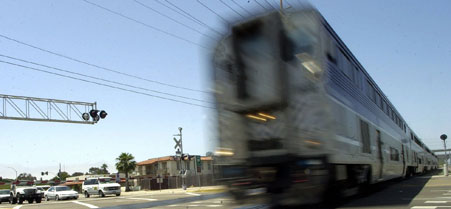Hackers manipulated railway computers, TSA memo says
The Transportation Security Administration supplied transit companies with a play-by-play account of the December situation to prevent a broader attack.
 Lenny Ignelzi/AP File
Lenny Ignelzi/AP File
This story has been updated with new information from the railroad industry and to clearly state the industry's contention that the TSA memo was inaccurate.
Hackers, possibly from abroad, executed an attack on a Northwest rail company's computers that disrupted railway signals for two days in December, according to a government memo recapping outreach with the transportation sector during the emergency.
On Dec. 1, train service on the unnamed railroad "was slowed for a short while" and rail schedules were delayed about 15 minutes after the interference, stated a Transportation Security Administration summary of a Dec. 20 meeting about the episode obtained by Nextgov . The following day, shortly before rush hour, a "second event occurred" that did not affect schedules, TSA officials added. The agency is responsible for protecting all U.S. transportation systems, not just airports.
"Amtrak and the freight rails needed to have context regarding their information technical centers," the memo stated. "Cyberattacks were not a major concern to most rail operators" at the time, adding, "the conclusion that rail was affect [sic] by a cyberattack is very serious."
While government and critical industry sectors have made strides in sharing threat intelligence, less attention has been paid to translating those analyses into usable information for the people in the trenches, who are running the subways, highways and other transit systems, some former federal officials say. The recent TSA outreach was unique in that officials told operators how the breach interrupted the railway's normal activities, said Steve Carver, a retired Federal Aviation Administration information security manager, now an aviation industry consultant, who reviewed the memo.
"This TSA program is a start to bring, at a higher level, an understanding of the national impact to cyberattacks," Carver said. The U.S. Computer Emergency Readiness Team and the Pentagon's National Security Agency "have provided great information on the particular threat. They don't say how it has affected others. TSA tells you how it affected others."
The incident summary praised several TSA personnel for explaining the unfolding situation in context. When TSA investigators began to suspect the exploit was an intentional act rather than a glitch, they acted under the assumption it could present a broader danger to the U.S. transportation system, according to the memo.
"Some of the possible causes lead to consideration of an overseas cyberattack," the write-up stated. Investigators discovered two Internet access locations, or IP addresses, for the intruders on Dec. 1 and a third on Dec. 2, the document noted, but it does not say in which country they were located.
"Information stating the incidents were a targeted attack was not sent out" until midday on Monday, Dec. 5, according to the memo. The data that train operators needed to diffuse the situation was made available to them, officials wrote. Alerts listing the three IP addresses went out to several hundred railroad firms and public transportation agencies, as well as to partners in Canada.
"The processes set in place for government to work with the industry in real-time communications regarding a cyber event aligned superbly," the recap stated.
Participants in the Dec. 20 meeting included representatives from information technology firm Indus Corp., the Association of American Railroads, and Boeing Co., as well as government officials from TSA, the Homeland Security Department's cybersecurity divisions, the Transportation Department, and the U.S. Coast Guard.
But, on Monday, officials at the Homeland Security Department, which oversees TSA, said following additional in-depth analysis, it appears that the rail infiltration may not have been a targeted attack.
"On December 1, a Pacific Northwest transportation entity reported that a potential cyber incident could affect train service," DHS spokesman Peter Boogaard said. "The Department of Homeland Security, the FBI and our federal partners remained in communication with representatives from the transportation entity in support of their mitigation activities and with state and local government officials to send alerts to notify the transportation community of the anomalous activity as it was occurring."
Based on the memo, it is unclear if other railway companies have experienced similar network incidents. Companies often are reluctant to discuss computer breaches openly for fear of scaring off customers. And, sometimes, businesses never detect the intrusions, they add.
For government to improve cyber emergency response, "the biggest thing is to start with the communications staff," Carver recommends. "There needs to be an interpreter who can take the information coming out of the U.S. CERT, take that, extract that out, and determine what it means for operations."
Rail industry representatives said they were not at liberty to discuss the contents of the government memo but said the memo was inaccurate. "There was no targeted computer-based attack on a railroad," said Holly Arthur, a spokeswoman for the Association of American Railroads. "Railroads closely monitor cyber security as a fully integrated part of both the industry's overall security plan, as well as individual company plans. Continuous coordination on cyber security occurs across the industry and with the federal government," she said.
"In addition to security measures, railroads like other high tech industries have multiple backup capabilities and ultimately manual operation procedures to address virtually any type of disruption," Arthur said.



